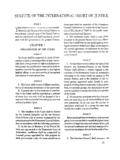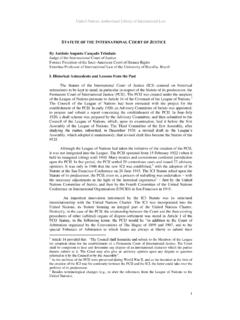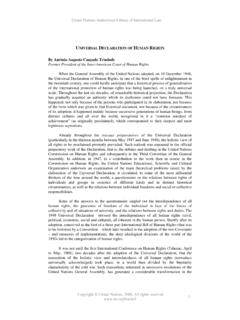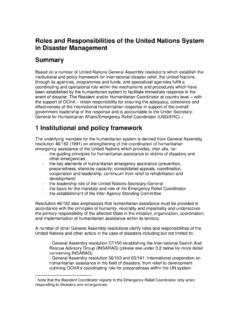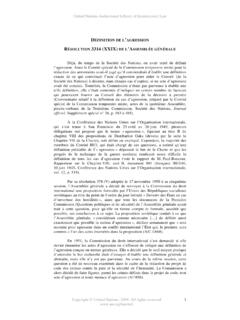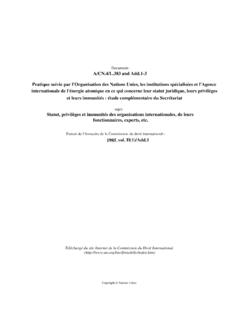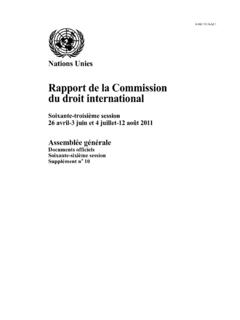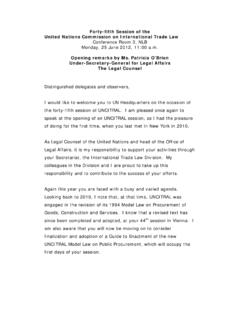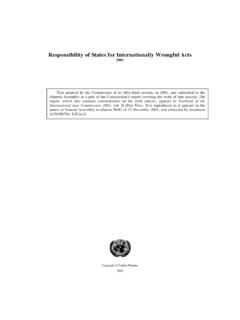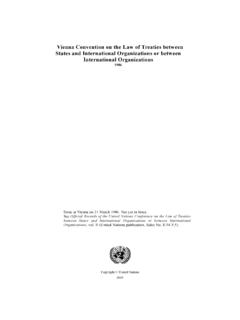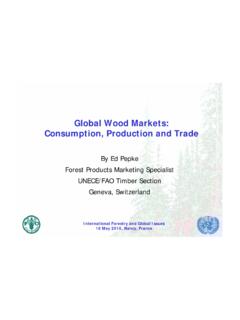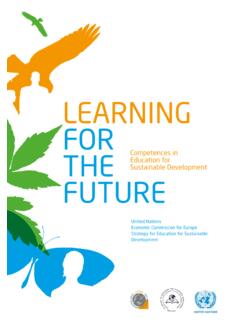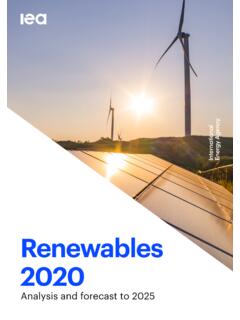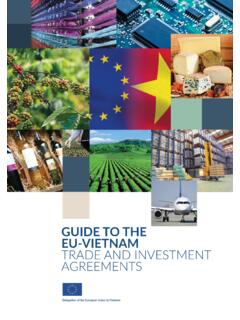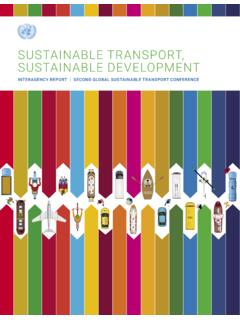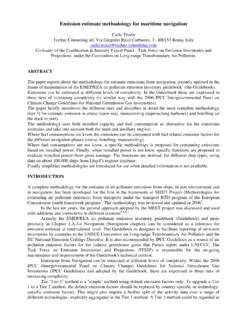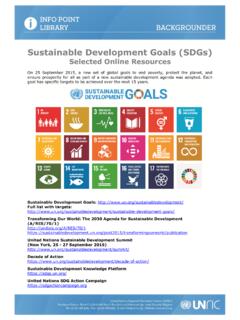Transcription of Convention on the Law of Non-navigational Uses of ...
1 Convention on the Law of the Non-navigational Uses of International Watercourses 1997 Adopted by the General Assembly of the United Nations on 21 May 1997. Entered into force on 17 August 2014. See General Assembly resolution 51/229, annex, Official Records of the General Assembly, Fifty-first Session, Supplement No. 49 (A/51/49). Copyright United Nations 2014 2 Convention on the Law of the Non-navigational Uses of International Watercourses Adopted by the General Assembly of the United Nations on 21 May 1997 The Parties to the present Convention , Conscious of the importance of international watercourses and the Non-navigational uses thereof in many regions of the world, Having in mind Article 13, paragraph 1 (a), of the Charter of the United Nations, which provides that the General Assembly shall initiate studies and make recommendations for the purpose of encouraging the progressive development of international law and its codification, Considering that successful codification and progressive development of rules of international law regarding Non-navigational uses of international watercourses would assist in promoting and implementing the purposes and principles set forth in Articles 1 and 2 of the Charter of the United Nations, Taking into account the problems affecting many international watercourses resulting from, among other things, increasing demands and pollution, Expressing the conviction that a framework Convention will ensure the utilization, development, conservation.
2 Management and protection of international watercourses and the promotion of the optimal and sustainable utilization thereof for present and future generations, Affirming the importance of international cooperation and good-neighbourliness in this field, Aware of the special situation and needs of developing countries, Recalling the principles and recommendations adopted by the United Nations Conference on Environment and Development of 1992 in the Rio Declaration and Agenda 21, Recalling also the existing bilateral and multilateral agreements regarding the Non-navigational uses of international watercourses, Mindful of the valuable contribution of international organizations, both governmental and non-governmental, to the codification and progressive development of international law in this field, Appreciative of the work carried out by the International Law Commission on the law of the Non-navigational uses of international watercourses, Bearing in mind United Nations General Assembly resolution 49/52 of 9 December 1994, Have agreed as follows: 3 PART I.
3 INTRODUCTION Article 1 Scope of the present Convention 1. The present Convention applies to uses of international watercourses and of their waters for purposes other than navigation and to measures of protection, preservation and management related to the uses of those watercourses and their waters. 2. The uses of international watercourses for navigation is not within the scope of the present Convention except insofar as other uses affect navigation or are affected by navigation. Article 2 Use of terms For the purposes of the present Convention : (a) Watercourse means a system of surface waters and groundwaters constituting by virtue of their physical relationship a unitary whole and normally flowing into a common terminus; (b) International watercourse means a watercourse, parts of which are situated in different States; (c) Watercourse State means a State Party to the present Convention in whose territory part of an international watercourse is situated, or a Party that is a regional economic integration organization, in the territory of one or more of whose Member States part of an international watercourse is situated.
4 (d) Regional economic integration organization means an organization constituted by sovereign States of a given region, to which its member States have transferred competence in respect of matters governed by this Convention and which has been duly authorized in accordance with its internal procedures, to sign, ratify, accept, approve or accede to it. Article 3 Watercourse agreements 1. In the absence of an agreement to the contrary, nothing in the present Convention shall affect the rights or obligations of a watercourse State arising from agreements in force for it on the date on which it became a party to the present Convention . 2. Notwithstanding the provisions of paragraph 1, parties to agreements referred to in paragraph 1 may, where necessary, consider harmonizing such agreements with the basic principles of the present Convention . 3. Watercourse States may enter into one or more agreements, hereinafter referred to as watercourse agreements , which apply and adjust the provisions of the present Convention to the characteristics and uses of a particular international watercourse or part thereof.
5 4 4. Where a watercourse agreement is concluded between two or more watercourse States, it shall define the waters to which it applies. Such an agreement may be entered into with respect to an entire international watercourse or any part thereof or a particular project, programme or use except insofar as the agreement adversely affects, to a significant extent, the use by one or more other watercourse States of the waters of the watercourse, without their express consent. 5. Where a watercourse State considers that adjustment and application of the provisions of the present Convention is required because of the characteristics and uses of a particular international watercourse, watercourse States shall consult with a view to negotiating in good faith for the purpose of concluding a watercourse agreement or agreements. 6. Where some but not all watercourse States to a particular international watercourse are parties to an agreement, nothing in such agreement shall affect the rights or obligations under the present Convention of watercourse States that are not parties to such an agreement.
6 Article 4 Parties to watercourse agreements 1. Every watercourse State is entitled to participate in the negotiation of and to become a party to any watercourse agreement that applies to the entire international watercourse, as well as to participate in any relevant consultations. 2. A watercourse State whose use of an international watercourse may be affected to a significant extent by the implementation of a proposed watercourse agreement that applies only to a part of the watercourse or to a particular project, programme or use is entitled to participate in consultations on such an agreement and, where appropriate, in the negotiation thereof in good faith with a view to becoming a party thereto, to the extent that its use is thereby affected. PART II. GENERAL PRINCIPLES Article 5 Equitable and reasonable utilization and participation 1. Watercourse States shall in their respective territories utilize an international watercourse in an equitable and reasonable manner.
7 In particular, an international watercourse shall be used and developed by watercourse States with a view to attaining optimal and sustainable utilization thereof and benefits therefrom, taking into account the interests of the watercourse States concerned, consistent with adequate protection of the watercourse. 2. Watercourse States shall participate in the use, development and protection of an international watercourse in an equitable and reasonable manner. Such participation includes both the right to utilize the watercourse and the duty to cooperate in the protection and development thereof, as provided in the present Convention . 5 Article 6 Factors relevant to equitable and reasonable utilization 1. Utilization of an international watercourse in an equitable and reasonable manner within the meaning of article 5 requires taking into account all relevant factors and circumstances, including: (a) Geographic, hydrographic, hydrological, climatic, ecological and other factors of a natural character; (b) The social and economic needs of the watercourse States concerned; (c) The population dependent on the watercourse in each watercourse State; (d) The effects of the use or uses of the watercourses in one watercourse State on other watercourse States; (e) Existing and potential uses of the watercourse; (f) Conservation, protection, development and economy of use of the water resources of the watercourse and the costs of measures taken to that effect; (g) The availability of alternatives, of comparable value, to a particular planned or existing use.
8 2. In the application of article 5 or paragraph 1 of this article, watercourse States concerned shall, when the need arises, enter into consultations in a spirit of cooperation. 3. The weight to be given to each factor is to be determined by its importance in comparison with that of other relevant factors. In determining what is a reasonable and equitable use, all relevant factors are to be considered together and a conclusion reached on the basis of the whole. Article 7 Obligation not to cause significant harm 1. Watercourse States shall, in utilizing an international watercourse in their territories, take all appropriate measures to prevent the causing of significant harm to other watercourse States. 2. Where significant harm nevertheless is caused to another watercourse State, the States whose use causes such harm shall, in the absence of agreement to such use, take all appropriate measures, having due regard for the provisions of articles 5 and 6, in consultation with the affected State, to eliminate or mitigate such harm and, where appropriate, to discuss the question of compensation.
9 Article 8 General obligation to cooperate 6 1. Watercourse States shall cooperate on the basis of sovereign equality, territorial integrity, mutual benefit and good faith in order to attain optimal utilization and adequate protection of an international watercourse. 2. In determining the manner of such cooperation, watercourse States may consider the establishment of joint mechanisms or commissions, as deemed necessary by them, to facilitate cooperation on relevant measures and procedures in the light of experience gained through cooperation in existing joint mechanisms and commissions in various regions . Article 9 Regular exchange of data and information 1. Pursuant to article 8, watercourse States shall on a regular basis exchange readily available data and information on the condition of the watercourse, in particular that of a hydrological, meteorological, hydrogeological and ecological nature and related to the water quality as well as related forecasts.
10 2. If a watercourse State is requested by another watercourse State to provide data or information that is not readily available, it shall employ its best efforts to comply with the request but may condition its compliance upon payment by the requesting State of the reasonable costs of collecting and, where appropriate, processing such data or information. 3. Watercourse States shall employ their best efforts to collect and, where appropriate, to process data and information in a manner which facilitates its utilization by the other watercourse States to which it is communicated. Article 10 Relationship between different kinds of uses 1. In the absence of agreement or custom to the contrary, no use of an international watercourse enjoys inherent priority over other uses. 2. In the event of a conflict between uses of an international watercourse, it shall be resolved with reference to articles 5 to 7, with special regard being given to the requirements of vital human needs.
